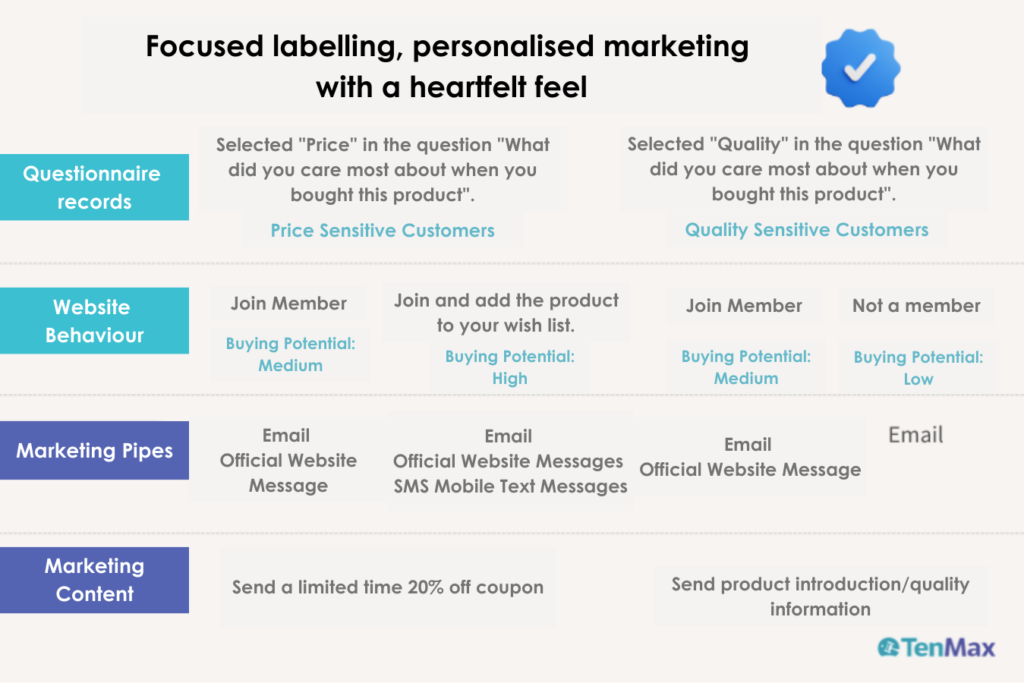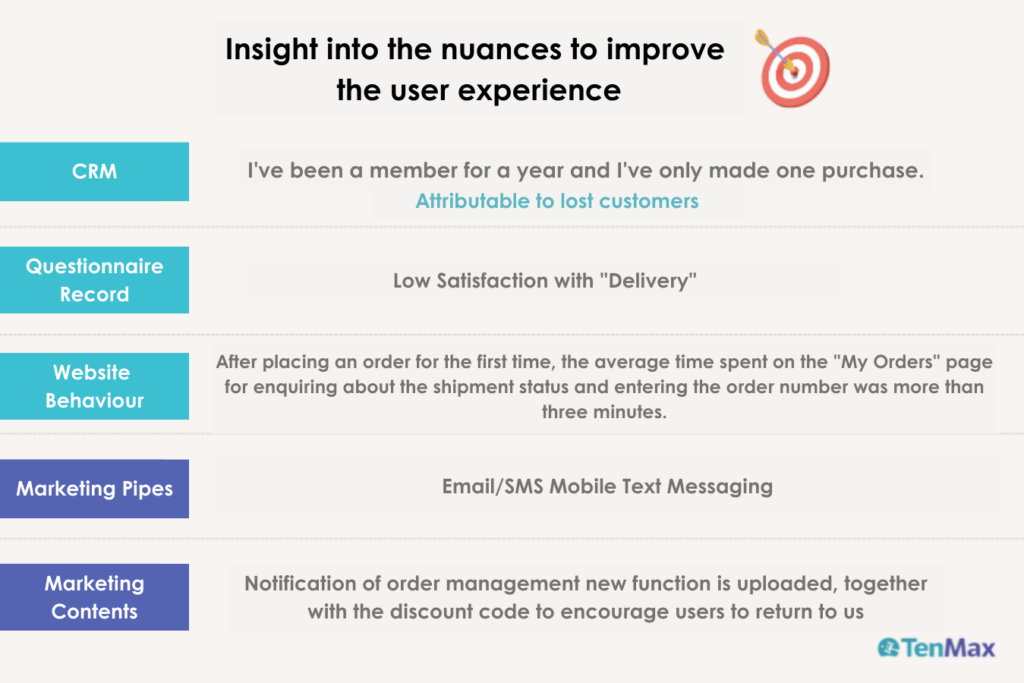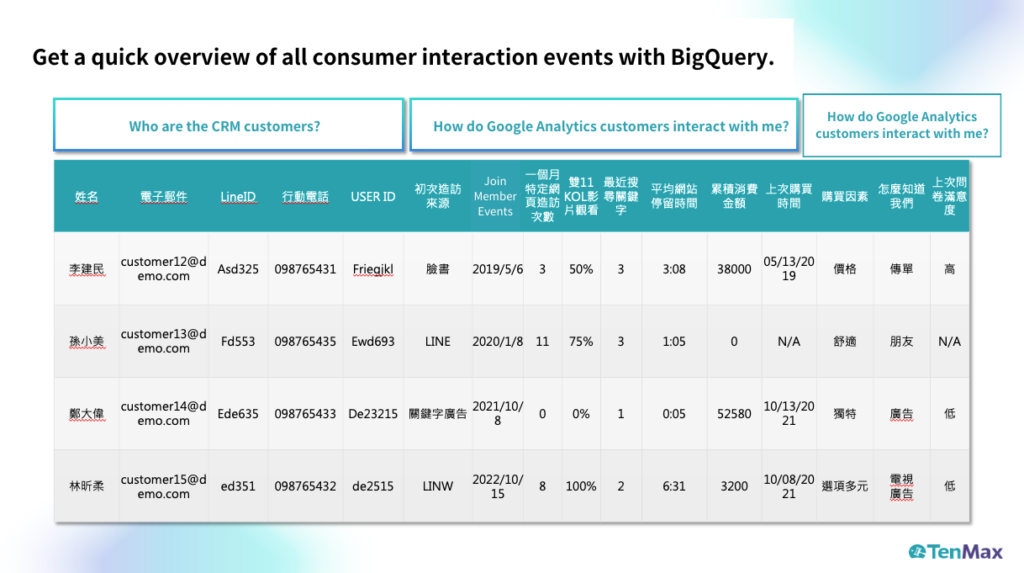As the cost of acquiring new customers continues to rise annually, the importance of maintaining existing customers becomes increasingly evident. In recent years, “membership management” has become a prominent focus: how should a brand accurately understand the hearts of existing users and, in conjunction with marketing strategies, drive a continuous sales flywheel? It all starts with “data collection.” When a brand can gather comprehensive member data, including personal information, purchasing habits, and value preferences, it can further categorize members and devise the most suitable marketing communication methods. In today’s environment with restricted third-party data, first-party and zero-party data obtained with user consent are invaluable assets for marketers.
In the previous article, we shared how to use SurveyCake to create survey pages and integrate them with Google Analytics 4 (referred to as “GA4”) for tracking and analysis. In this article, we will take it a step further by consolidating the website and survey data collected by GA4 into BigQuery, fully leveraging the marketing application value of first-party and zero-party data.
Google Analytics vs. BigQuery: Complementary Marketing Powerhouses
Why integrate BigQuery when GA4 is already in use? While GA4 enables marketers to perform actions such as event tracking and data analysis, integrating BigQuery takes it a step further by allowing for the comprehensive and permanent storage of data collected by GA4. This integration also facilitates the use of SQL for data retrieval, analysis, and export applications. Below are three specific advantages of integrating GA4 with BigQuery:
1. Comprehensive and Permanent Storage of Non-Sampled Website Data:
When dealing with a substantial volume of data exceeding specific thresholds, GA4 automatically employs data processing methods such as “sampling” and “compression.” This implies that the analytical results presented by GA4 may not necessarily reflect the entire dataset, potentially introducing inaccuracies compared to the actual scenario. In contrast, integrating GA4 with BigQuery allows for the importation of all “non-sampled data,” preserving each piece of information entirely for subsequent indexing and analysis. Regarding data storage limitations, GA4 retains data for a maximum of 14 months, while integration with BigQuery removes time constraints, enabling the perpetual preservation of data.
2. Greater Flexibility: Custom Indexing and Analysis Conditions Using SQL Syntax
In GA4, predefined data metrics and analysis dimensions are available, facilitating marketers in pulling reports and viewing summarized traffic insights. However, for in-depth indexing and analysis beyond the system defaults—such as data filtering and comparisons with multiple conditions—one needs to issue commands through SQL within BigQuery. Since BigQuery preserves complete, non-sampled, and uncompressed data, coupled with the ability to perform complex data analysis using programming syntax, it enhances the flexibility and depth of data utilization.
3. Practical Integration: Constructing a Comprehensive Perspective by Combining CRM Data
BigQuery data can be integrated with variables from other sources, allowing for the creation and comparison of various business models (e.g., NES, RFM). This integration facilitates the establishment of a holistic customer view. While CRM data informs us “who the customers are,” the data imported into BigQuery from GA4 can further illustrate the interactions between customers and the brand. This includes website behavior, survey feedback, and more, assisting the brand in gaining a deeper and more comprehensive understanding of its customers.

SurveyCake Survey Data Combined with GA4 + BigQuery: Crafting a 360-Degree Customer View
Utilizing GA4 to gather visitors’ web browsing behavior (first-party data) and user responses from surveys (zero-party data) with the integration of BigQuery, along with the existing CRM customer database, creates a seamless connection of the “customer view.” This integration is beneficial for subsequent data identification, consolidation, and matching to individual users. In BigQuery, not only can custom conditions be applied for indexing and user segmentation analysis, but it also allows for observing a complete view of individual entities, enhancing overall marketing efficiency. Let’s explore a few application examples below!
[ Scenario 1 ] Segmentation and Personalized Marketing for a Thoughtful Approach
An innovative design brand, before launching Product A, conducted a pre-crowdfunding survey, encouraging respondents to join as members to receive the latest promotional information. After the release of Product A, the brand utilized GA4 and BigQuery to extract users from the pre-crowdfunding survey who identified “price” as the most important purchasing factor (User Group A) and those who chose “quality” as the primary factor (User Group B). The brand then analyzes the website interactions of these two user groups to tailor a more personalized marketing approach.
- Judgment : Through the crowdfunding survey, users who responded can be effectively segmented and labeled. For instance, by considering the user’s most emphasized purchasing factor, customers can be classified into “price-sensitive” User Group A and “quality-sensitive” User Group B. Secondly, in conjunction with CRM and GA4, the data recorded and stored in BigQuery help differentiate users’ purchasing potential. For example, within User Group A, some users join the website as members, and specific members even add Product A to their wishlists. In User Group B, audiences can be further categorized into those who have and have not joined as members.
- Action: For price-sensitive users in User Group A who have already joined as members, promotional emails and website messages are sent, offering a time-limited 20% discount coupon and free shipping. Additionally, for high-potential customers who have added Product A to their wishlists, supplementary SMS messages are sent. For quality-sensitive users in User Group B, emails containing information about product design details, materials used, inspection certifications, etc., are sent to non-member users. For those who are already members, communication is enhanced through website messages.

[ Scenario 2 ] Observing Details: Integrating Website and Survey Data
A fashion e-commerce business has observed that some customers, who have been members for over a year, have only made a single purchase. Subsequently, they repeatedly add items to their shopping carts but never proceed to checkout. Combining this insight with post-purchase surveys, it was found that this customer segment generally expresses low satisfaction with “product delivery.” Analyzing the data with GA4 reveals that after placing an order, these customers frequently enter the “My Orders” section to check the shipment status. Moreover, on the page where they input the order number, the average dwell time exceeds 3 minutes.
- Judgment : Users with previous purchase history and sustained shopping intent are considered crucial to retain. Combining survey results with website behavioral data indicates that these users are particularly concerned about the progress of order processing. However, the segment’s time-consuming efforts in filling out the order number for tracking might affect their willingness to make repeat purchases.
- Action: The marketing department decided to integrate the order management system with communication tools such as LINE and Messenger to provide real-time updates on order progress. Additionally, they send emails and SMS messages to the identified users, notifying them of the new feature and encouraging them to complete their purchase with a discount code.

[ Scenario 3 ] Integration of Virtual and Real: Optimizing Offline Service Aspects with Online Insights
In the restaurant industry, CRM member data is integrated with BigQuery for storage and subsequent audience calculations. It is discovered that Customer A has made 5 visits to the restaurant within the past six months, with total spending exceeding ten thousand dollars. Post-dining surveys reveal that for each visit, the purpose is marked as “business gathering,” and Customer A expresses high satisfaction with aspects such as pricing and the menu. However, satisfaction levels are comparatively lower for restaurant ambiance and service personnel.
- Judgment : The user has a high lifetime value and can be considered a VIP customer, warranting proactive cultivation.
- Action: For Customer A, the marketing team decided to send “Free VIP Room Upgrade Vouchers” via email and SMS. This is aimed at guiding the customer to experience the VIP room ambiance and service, thereby enhancing overall satisfaction. The goal is to encourage the user to consider reserving a VIP room for their next visit. Additionally, leveraging geolocation, customized marketing efforts are initiated. Regular promotions related to the area where Customer A is located are pushed, enhancing incentives for continuous in-store spending.

Gaining Insight into Consumer Hearts from the Inside Out, Enhancing Communication Effectiveness with Marketing Applications
CRM data and website behavior records aid brands in understanding customers’ personal information and purchase history. Surveys, on the other hand, enable the capture of concealed aspects within purchase records, such as consumption intent, personal preferences, and unmet needs. With well-designed surveys, it is possible to further explore emotional consumption demands and qualities that truly matter to customers. The synergy of quantitative and qualitative data contributes collectively to the creation of a more comprehensive and profound marketing strategy. On another front, the demographic data mentioned above can be integrated with marketing automation tools to design corresponding marketing pathways, scaling up overall communication efficiency.

TenMax possesses extensive experience in data applications and product integration. As an official Oracle technology partner, TenMax develops marketing automation tools for the Taiwan market that seamlessly integrate LINE and SMS. With self-developed DMP (Data Management Platform) and CDP (Customer Data Platform), TenMax has handled data collection and cleaning processes far more complex than GA (Google Analytics). Notably, TenMax has contributed to the development of a data advertising platform for the Southeast Asian unicorn, GoJek, managing a daily volume of data in the billions. Embark on your data journey now! Contact TenMax to discover how to effectively track and leverage website data and survey information, complemented by BigQuery, to achieve innovative marketing applications.
This article is authorized by TenMax
Author:Tobey
Read More:



-5_page-0001.jpg)
-3_page-0001.jpg)
